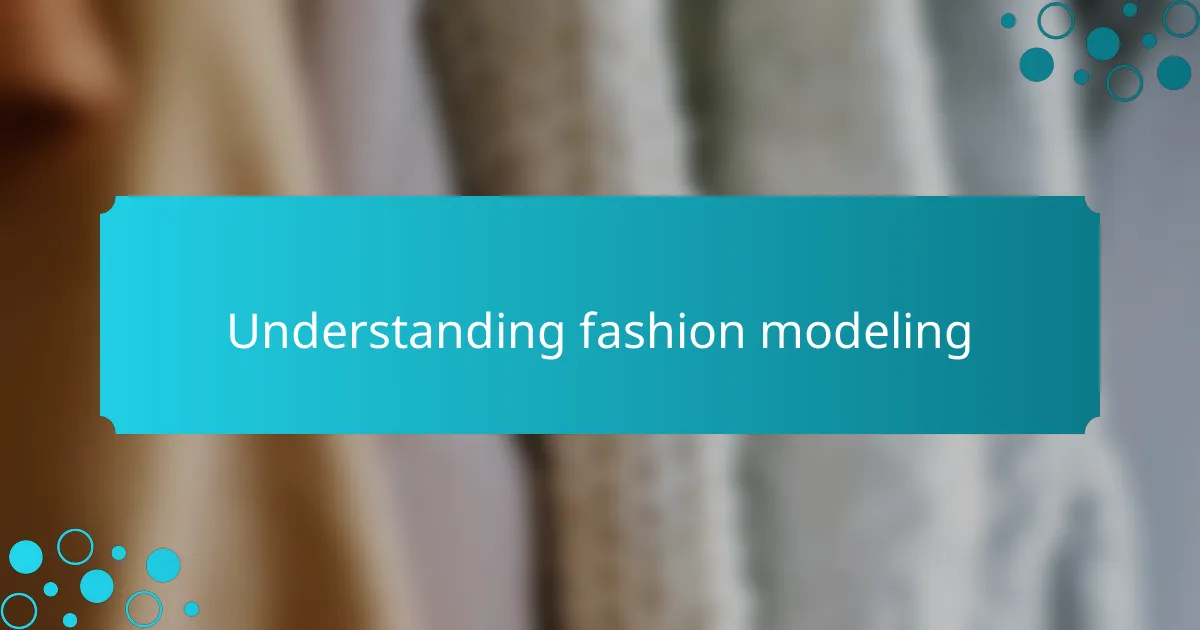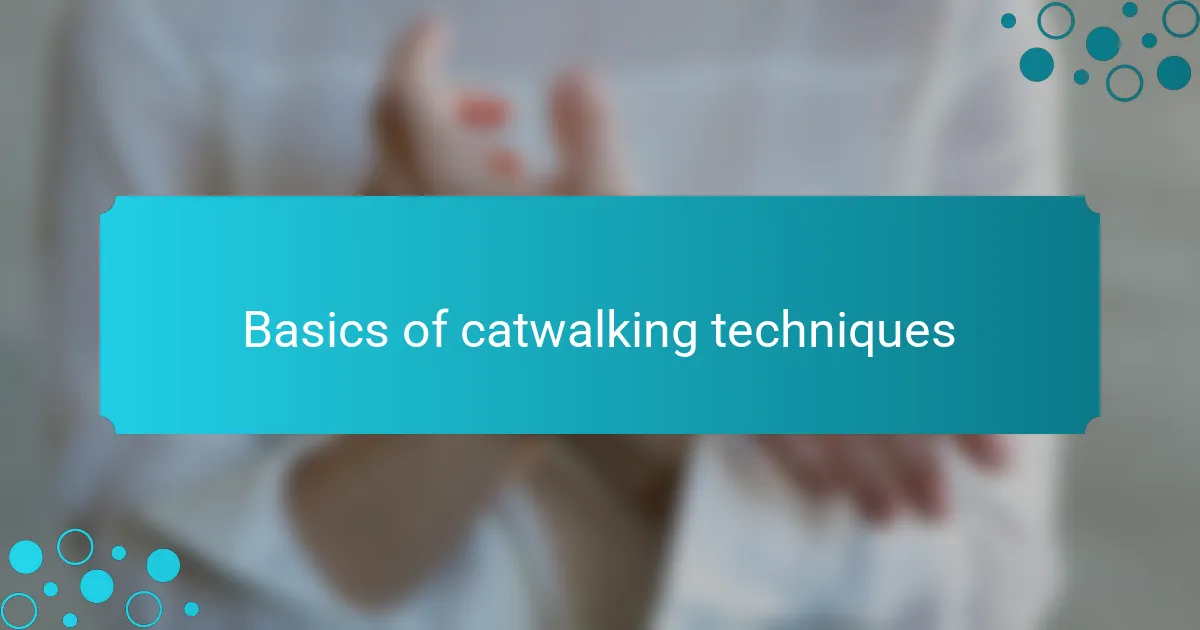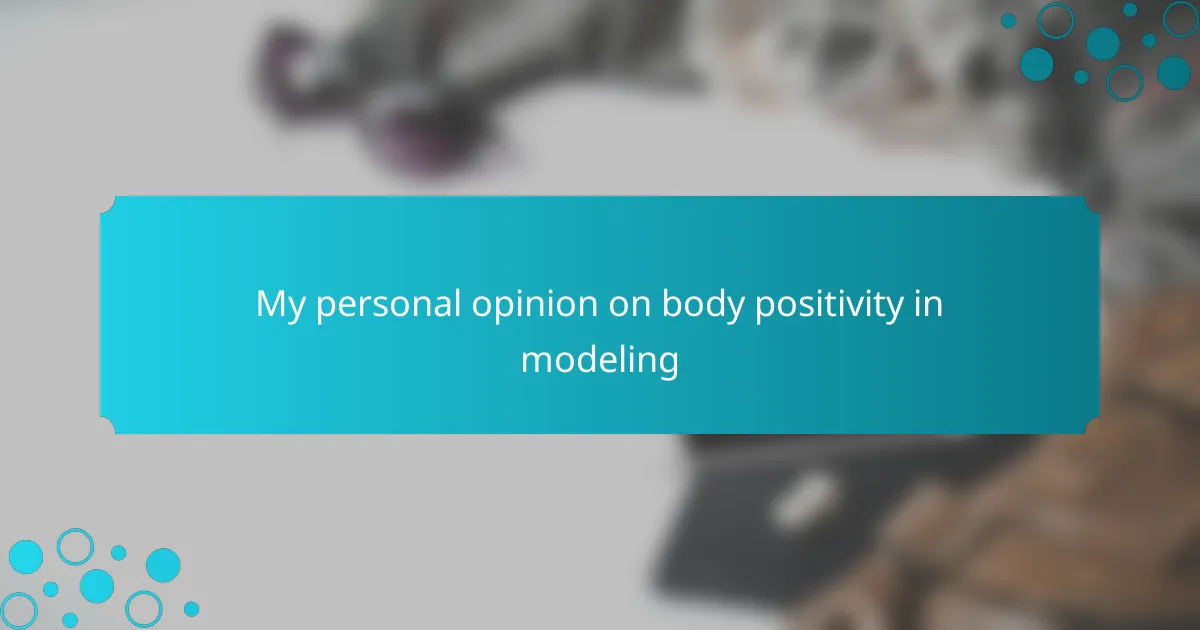Key takeaways
- Fashion modeling combines confidence, posture, and emotional connection to effectively present a designer’s vision.
- Catwalking is an art form that requires deliberate movements, engaging with the audience, and embodying the brand’s essence.
- Training through self-practice and professional workshops is crucial for mastering catwalking techniques and overcoming challenges.
- Personal experiences highlight the importance of resilience, maintaining own style, and learning from setbacks in a competitive environment.

Understanding fashion modeling
Fashion modeling is a dynamic and multifaceted world where every catwalk tells a story of elegance, confidence, and creativity. I remember my first experience stepping on a runway; my heart raced as the lights flooded my face, but I learned that modeling is not just about looking good—it’s about embodying the essence of the designer’s vision. The thrill of stepping out in a stunning outfit, surrounded by the buzz of cameras and applause, is truly electrifying.
Understanding fashion modeling involves grasping several key elements. Here are a few insights I’ve gained along the way:
- Posture and poise: A model’s body language speaks volumes. Standing tall with confidence can make all the difference.
- Presentation skills: It’s essential to know how to showcase garments to their best advantage, highlighting textures and colors effortlessly.
- Industry knowledge: Familiarizing yourself with designers, trends, and techniques can help you adapt and thrive in this fast-paced environment.
- Emotional connection: Engaging with the audience and evoking emotions through your expressions can turn a simple walk into an unforgettable performance.
- Networking: Building relationships with photographers, stylists, and other models is crucial for success in this competitive field.
These elements have not only shaped my approach to modeling but also enriched my understanding of fashion as an art form.

Importance of catwalking
Catwalking is more than just walking; it’s a form of expression and confidence. I remember the first time I stepped onto a runway in New York—a whirl of lights, music, and the top designers’ creations. That moment taught me that every step not only showcases the fashion but also tells a story about who I am.
Understanding the significance of catwalking can shape a model’s career. It goes beyond aesthetics; it’s about embodying the designer’s vision and engaging the audience. I found that each stride builds my self-esteem, making me feel like I can conquer anything, both on and off the runway.
Here’s a simple comparison of traditional walking versus catwalking:
| Traditional Walking | Catwalking |
|---|---|
| Casual pace, often unaware of posture | Deliberate pace, focused on posture and style |
| Reflects day-to-day activity | Represents art and fashion |
| Less focus on audience engagement | Engages and captivates audience |

Basics of catwalking techniques
Mastering the fundamentals of catwalking is essential for any aspiring model. One key technique to focus on is your posture; standing tall not only exudes confidence but also enhances the overall look of the outfit. I recall practicing in front of a mirror, adjusting my stance until I found that balance between strength and grace. It can be uncomfortable at first, but trust me, the more you practice, the more natural it feels.
Foot placement is another crucial element of effective catwalking. Each step should be deliberate, echoing the rhythm of the music while maintaining an elegant flow. There were times I struggled with my pace—I wanted to rush out of excitement—but I learned that slowing down and allowing the garment to speak makes all the difference. Have you ever noticed how a confident walk captures attention? It’s all about finding your groove and letting the audience bask in the beauty of each movement.
Lastly, expressing emotions through your [censured] expressions can elevate your performance from good to unforgettable. I remember the advice given to me by an experienced model: “Let your face tell a story, too.” When I finally started to engage with the audience, I felt an exhilarating connection. It’s as if my walk had transformed into a shared experience rather than a solo act. Those little details can truly enhance your presence on the runway.

Training for effective catwalking
Training for effective catwalking is crucial for any aspiring model. From my experience, perfecting your stride can make a world of difference during a runway show. I remember spending countless hours practicing in front of the mirror, focusing on posture and movement. Connecting with the rhythm of the music while walking is something I found enhances my confidence and presence on the runway.
In addition to practicing regularly, I sought professional guidance. Attending workshops led by seasoned models taught me invaluable techniques, such as how to engage with the audience and maintain poise. It’s not just about the walk; it’s about telling a story with your movements, which is a skill that comes with time and patience.
Here’s a comparison of different training methods:
| Training Method | Pros |
|---|---|
| Self-Practice | Improves comfort and confidence, allows for flexibility |
| Professional Workshops | Access to expert techniques, personalized feedback |
| Video Tutorials | Convenience and cost-effective, can be revisited for practice |

My personal journey in catwalking
My experience with catwalking in New York started unexpectedly. I vividly recall my first runway show, where I was both exhilarated and terrified. The energy in the room was electric, and stepping onto that runway felt like being thrust into a spotlight I had only dreamed about. I quickly learned the importance of confidence, as each step required not just poise, but a connection with the audience.
Through countless rehearsals and shows, I’ve picked up some invaluable lessons along the way. Here’s what I’ve learned about mastering the art of catwalking:
- Mind Your Posture: It’s all about standing tall and keeping your shoulders back. Good posture not only enhances your look but also exudes confidence.
- Practice Balance: Walking elegantly on heels can be tricky. I found it helpful to practice walking on various surfaces to develop my balance.
- Embody the Brand: Each show embodies a unique essence. I always aim to channel the designer’s vision while adding my personal flair.
- Connect with the Audience: Eye contact and [censured] expressions can elevate your performance. I often imagine I’m sharing a moment with someone in the crowd.
- Stay Resilient: Setbacks are part of the journey. There were moments I stumbled, both literally and figuratively, but those became my stepping stones toward improvement.

Challenges faced while learning
Learning to catwalk in New York wasn’t always glamorous. I faced numerous challenges that tested my resolve and passion for modeling. One vivid memory was during my first runway practice; I stumbled in front of seasoned models, feeling the heat of embarrassment wash over me. That experience taught me that all models have faced their fair share of mishaps.
Here are some challenges I encountered along the way:
- Mastering the right posture and poise took countless hours of practice.
- Overcoming nerves was crucial, especially during my initial performances.
- The competitive atmosphere in New York often felt overwhelming.
- I struggled with finding my personal style amidst a sea of trends.
- Learning to handle critique became essential for growth.
Each hurdle pushed me closer to finding my stride on that runway.



